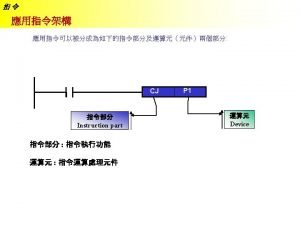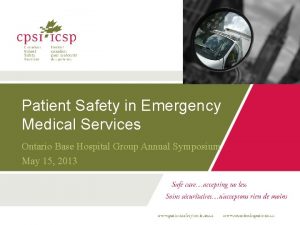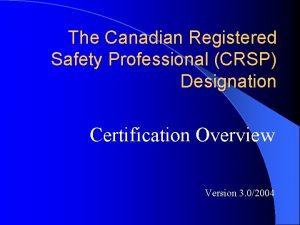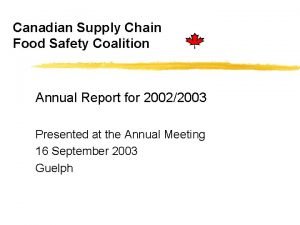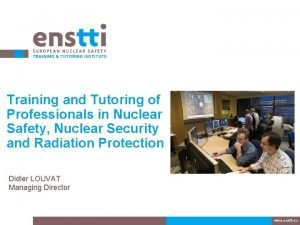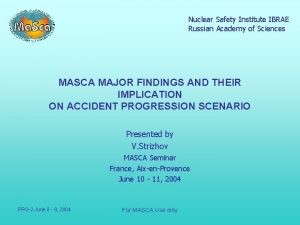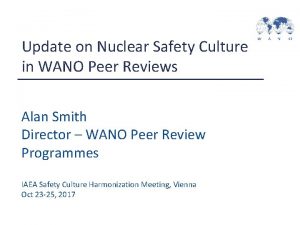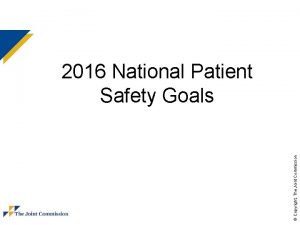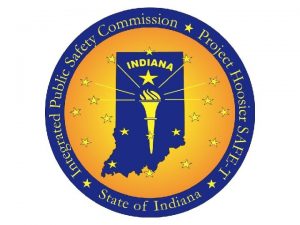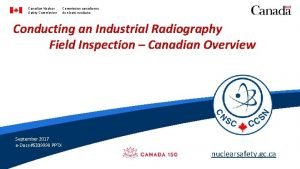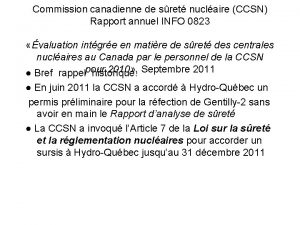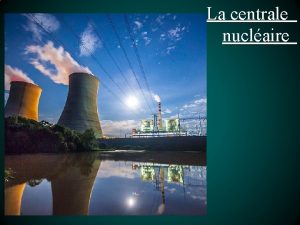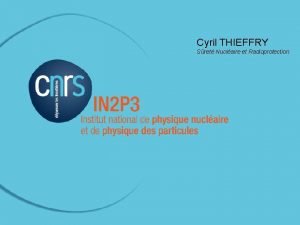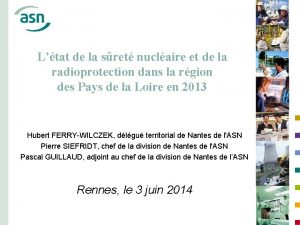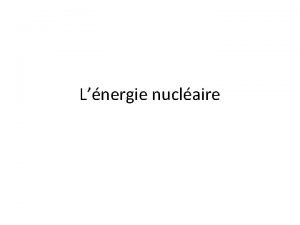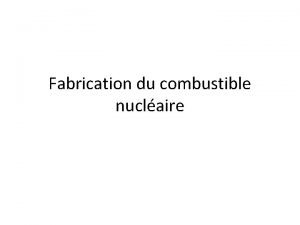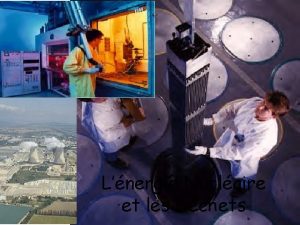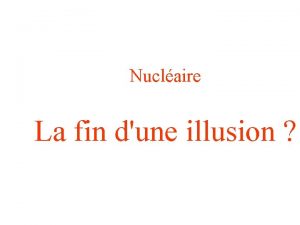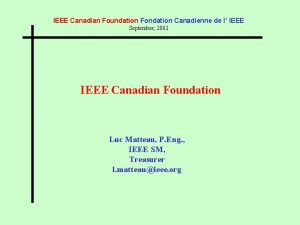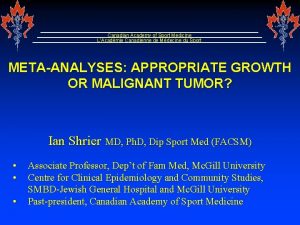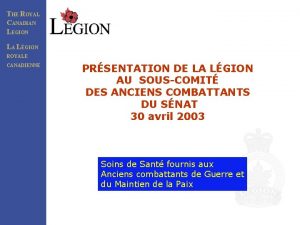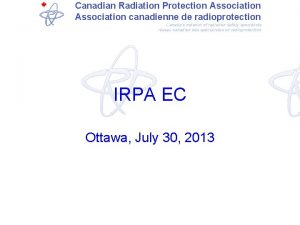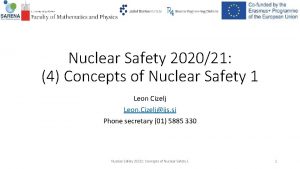Canadian Nuclear Safety Commission canadienne de sret nuclaire




























- Slides: 28

Canadian Nuclear Safety Commission canadienne de sûreté nucléaire CANADIAN REGULATORY APPROACH TO ENHANCEMENT OF THE ‘PASSIVE’ SAFETY CONCEPT International Conference on Topical Issues in Nuclear Installation Safety: Safety Demonstration of Advanced Water Cooled Nuclear Power Plants R. Rulko, D. Mroz, N. Shykinov 06 -09 June 2017, Vienna, Austria nuclearsafety. gc. ca

Outline • • Introduction Passive concept Canadian context International context Possible improvements Path forward Conclusions e-Docs # 5194403 Intl Conference on Topical Issues in Nuclear Installation Safety: Safety Demonstration of Advanced Water Cooled NPPs, IAEA, 6 -9, June, 2017

Canadian Nuclear Safety Commission Established May 2000, under the Nuclear Safety and Control Act Replaced the AECB, established in 1946, Atomic Energy Control Act Canada’s Independent Nuclear Regulator 71 Years Of Experience Canadian Nuclear Safety Commission Intl Conference on Topical Issues in Nuclear Installation Safety: Safety Demonstration of Advanced Water Cooled NPPs, 3

CNSC Regulates All Nuclear-Related Facilities and Activities • • Nuclear power plants Small reactors • • Waste management facilities Industrial and medical applications Nuclear research Export/import control Uranium mines and mills Uranium fuel fabricators and processing Canadian Nuclear Safety Commission Intl Conference on Topical Issues in Nuclear Installation Safety: Safety Demonstration of Advanced Water Cooled NPPs, IAEA, 6 -9, June, 2017 4

Introduction • CNSC staff reviewed and compared the use of the passive concept in regulatory requirements and guidelines published by international organizations and some national nuclear regulators e-Docs #5194403 Intl Conference on Topical Issues in Nuclear Installation Safety: Safety Demonstration of Advanced Water Cooled NPPs, IAEA, 6 -9, June, 2017

Passive Concept • The term ‘passive’ describes a particular strategy used in assuring an improved degree of safety of a reactor design • Application of a ‘passive’ safety concept varies from country to country, among vendors, regulators, or across specific nuclear applications e-Docs #5194403 Intl Conference on Topical Issues in Nuclear Installation Safety: Safety Demonstration of Advanced Water Cooled NPPs, IAEA, 6 -9, June, 2017

Passive Concept - Canadian Context REGDOC 3. 6, Glossary of CNSC Terminology, refers to the following passive items in the current CNSC regulatory framework: • • • Passive components, systems, buildings, vessels Passive engineered (nuclear) criticality safety control Passive measures Passive control (e. g. institutional or engineered control) Passive fire protection means e-Docs #5194403 Intl Conference on Topical Issues in Nuclear Installation Safety: Safety Demonstration of Advanced Water Cooled NPPs, IAEA, 6 -9, June, 2017

Passive Concept - International Context (IAEA) IAEA Safety Glossary defines the following passive items in the current IAEA framework: • Passive components, systems, elements • Passive measures (for institutional control) • Passively safe (for end state) e-Docs #5194403 Intl Conference on Topical Issues in Nuclear Installation Safety: Safety Demonstration of Advanced Water Cooled NPPs, IAEA, 6 -9, June, 2017

Passive Concept - International Context (IAEA) IAEA documents refer to: • Four categories of passive (A, B, C, D) with corresponding characteristics • Concept and degrees of passivity • Concepts of active and passive safety • Passive fuel load • Passive component and system • Passive response • Passive safety design e-Docs #5194403 • • • Passive operation Passive processes Passive safety characteristics Passively triggered Passive observation and confirmation Passive failure Intl Conference on Topical Issues in Nuclear Installation Safety: Safety Demonstration of Advanced Water Cooled NPPs, IAEA, 6 -9, June, 2017

Passive Concept - International Context (WENRA) Western European Nuclear Regulators Association (WENRA) refers to: • • • Failure of a passive component Passive safety functions Passive provisions Means of passive safety features Passive means Passive components e-Docs #5194403 Intl Conference on Topical Issues in Nuclear Installation Safety: Safety Demonstration of Advanced Water Cooled NPPs, IAEA, 6 -9, June, 2017

Passive Concept - International Context (EUR) European Utility Requirements (EUR) distinguish: • Passive component - function requires only structural integrity • Passive equipment - function requires only structural integrity but there are several degrees of passivity Passive Safety Features consist of Passive Systems or Passive Equipment - these perform passive safety functions e-Docs #5194403 Intl Conference on Topical Issues in Nuclear Installation Safety: Safety Demonstration of Advanced Water Cooled NPPs, IAEA, 6 -9, June, 2017

Passive Concept - National Context (US NRC, Korea KINS) US NRC considers: • Adjusting emergency planning zones for advanced reactors with passive design safety features • Age-related degradation on the performance of structures and components of passive safety systems Korea’s KINS considers: • Aging management programs for the long-lived passive components e-Docs #5194403 Intl Conference on Topical Issues in Nuclear Installation Safety: Safety Demonstration of Advanced Water Cooled NPPs, IAEA, 6 -9, June, 2017

Passive Concept - National Context (Russia, France) Russian Federation Gostechnadzor distinguishes: • Passive systems with mechanical moving parts (e. g. check valves) • Passive systems without mechanical moving parts (e. g. pipelines, vessels) French IRSN defined: • Main characteristics of passive safety systems • Main difficulties associated with assessing the performance and reliability of passive safety systems e-Docs #5194403 Intl Conference on Topical Issues in Nuclear Installation Safety: Safety Demonstration of Advanced Water Cooled NPPs, IAEA, 6 -9, June, 2017

Passive Concept - National Context (UK, Finland) The United Kingdom Office for Nuclear Regulation (ONR): • Defines the difference between inherent safety and passive safety • System PSA models should include passive component failures • Reliability of passive features or passive systems should be assessed and confirmed by testing Finnish Radiation and Nuclear Safety Authority (STUK): • Requires defining a design basis passive failure • A passive failure can be completely ignored if its probability can be demonstrated as sufficiently low e-Docs #5194403 Intl Conference on Topical Issues in Nuclear Installation Safety: Safety Demonstration of Advanced Water Cooled NPPs, IAEA, 6 -9, June, 2017

Passive Concept - National Context (Canada) • Current CNSC regulatory framework does not include explicit requirements or expectations with respect to the passive concept in NPP design • Passive concept appears in grading of requirements, e. g. , Single Failure Criterion principle can be excluded for passive SSCs • CNSC experience shows that vendors develop their own approach to passive systems design and credit it in safety analysis • In 2015 CNSC initiated a project on establishing a comprehensive approach to the passive concept with the objective of developing consistent passive design regulatory requirements e-Docs #5194403 Intl Conference on Topical Issues in Nuclear Installation Safety: Safety Demonstration of Advanced Water Cooled NPPs, IAEA, 6 -9, June, 2017

Possible Improvements The following terms have been identified throughout literature as virtually synonymous: • Passive safety, passive provisions, passive means, passive function, passive design, passive layer, passive principle, passive System, Structure, Component (SSC) e-Docs #5194403 Intl Conference on Topical Issues in Nuclear Installation Safety: Safety Demonstration of Advanced Water Cooled NPPs, IAEA, 6 -9, June, 2017

Possible Improvements New definitions and guidance have been developed on: • • • Passive barrier Passive conditions Categories of passivity Passive end state Passive failures e-Docs #5194403 Intl Conference on Topical Issues in Nuclear Installation Safety: Safety Demonstration of Advanced Water Cooled NPPs, IAEA, 6 -9, June, 2017

Possible Improvements – Definitions Passive barrier: • A physical barrier which uses passive means (SSC, phenomena) only Passive conditions: • Conditions of SSCs at defined plant states for which passive action is available as designed Example: ü ü reactor is critical or subcritical, PHT is hot or cold etc. state of containment, e. g. , locked airkocks SSC seismically qualified e-Docs #5194403 Intl Conference on Topical Issues in Nuclear Installation Safety: Safety Demonstration of Advanced Water Cooled NPPs, IAEA, 6 -9, June, 2017

Possible Improvements – Definitions Adoption of categories A, B, C, and D of passivity similar to the IAEA is proposed: • As per IAEA TECH DOC 626, transition from fully passive to fully active components/systems is defined as: A: 1+2+3+4 e-Docs #5194403 1. no moving working fluid B: 2+3+4 2. no moving mechanical part C: 3+4 3. no signal inputs of ‘intelligence’ D: 4 Intl Conference on Topical 4. no external power input or forces Issues in Nuclear Installation Safety: Safety Demonstration of Advanced Water Cooled NPPs, IAEA, 6 -9, June, 2017

Possible Improvements – Definitions Passive end state: • A safe and controlled state of nuclear facility or substance when all required safety functions are performed by passive SSC (categories from A to D) Passive failure: • Loss of integrity of a component or structure or the blockage of the flow path of a process • Passive failure shall refer to a failure mode that can be treated as an operational deficiency Note: passive failure and failure of passive SSC (loss of passive function) are different concepts e-Docs #5194403 Intl Conference on Topical Issues in Nuclear Installation Safety: Safety Demonstration of Advanced Water Cooled NPPs, IAEA, 6 -9, June, 2017

Possible Improvements – Passive Failure • Passive failures are characterized in general by material failure or longterm degradation • A passive failure relates to both reliability and availability of both passive and active SSCs • Passive component failures should be included in the system reliability models since they can lead to the failure of passive SSCs • Therefore, passive SSCs have limited reliability and capability and may fail or be insufficient under certain conditions e-Docs #5194403 Intl Conference on Topical Issues in Nuclear Installation Safety: Safety Demonstration of Advanced Water Cooled NPPs, IAEA, 6 -9, June, 2017

Possible Improvements – Definitions • Passive System, Structure, Component (SSC): ü passive component - a component of one of Passive Categories A, B, C or D ü passive system – a system built of Passive Category A, B, C or D components ü passive system category - determined by lowest category component in the context of the intended safety function Note: passive containment system is built of passive SSCs of cat. A, B, C or D; the structural elements are inherently passive Guidance has been developed on: • • • Passive administrative control – no definition required – generally not considered passive Passive phenomenon – no generic definition required – define driving phenomena case-by-case Inherent safety – needs work– currently means that ‘harm cannot happen’ e-Docs #5194403 Intl Conference on Topical Issues in Nuclear Installation Safety: Safety Demonstration of Advanced Water Cooled NPPs, IAEA, 6 -9, June, 2017

Possible Improvements – Inherent Safety The term “inherent safety” is widely used by regulators consideration should be given to the merits of: • possible “levels” of “inherent safety” • existence of “inherent hazards” as opposed to “inherent safety” • regulatory requirements for design dependent on the “levels” of “inherent” features e-Docs #5194403 Intl Conference on Topical Issues in Nuclear Installation Safety: Safety Demonstration of Advanced Water Cooled NPPs, IAEA, 6 -9, June, 2017

Path Forward Steps to consolidate the risk-informed approach to the passive concept: • International cooperation for developing more systematic and consistent approach, e. g. , IAEA, NEA, WENRA Reactor Harmonisation WG (RHWG), MDEP WG or other international organizations fora • Development of requirements and guidance for the application of passive concept based on the international approaches and best practices e-Docs #5194403 Intl Conference on Topical Issues in Nuclear Installation Safety: Safety Demonstration of Advanced Water Cooled NPPs, IAEA, 6 -9, June, 2017

Path Forward The proposed path forward is the development of: • Accepted passive design rules and passive safety analysis methodology • Examples and guidance for application of passive safety concept to various design solutions, including: ü ü e-Docs #5194403 specific SSC for large NPPs SMRs as integrated facilities or with integrated reactor design research reactors with “zero” power quality requirements for passive SSCs Intl Conference on Topical Issues in Nuclear Installation Safety: Safety Demonstration of Advanced Water Cooled NPPs, IAEA, 6 -9, June, 2017

Conclusions In Canada the following activities are needed: • Finalize draft definitions and guidance • Review and develop potential amendments to the identified CNSC documents • Interface and cooperate internationally on consistent approach to passive design principles e-Docs #5194403 Intl Conference on Topical Issues in Nuclear Installation Safety: Safety Demonstration of Advanced Water Cooled NPPs, IAEA, 6 -9, June, 2017

Conclusions • The current international regulatory framework needs improvements with respect to the rigorous interpretation of the application of passive and inherent safety concept and its impact on safety assessment e-Docs #5194403 Intl Conference on Topical Issues in Nuclear Installation Safety: Safety Demonstration of Advanced Water Cooled NPPs, IAEA, 6 -9, June, 2017

Canadian Nuclear Safety Commission canadienne de sûreté nucléaire Thank You ! e-Docs #5194403 nuclearsafety. gc. ca
 Asci hex
Asci hex Pyramide alimentaire canadienne
Pyramide alimentaire canadienne Vieux guide alimentaire canadien
Vieux guide alimentaire canadien Lesson 15 nuclear quest nuclear reactions
Lesson 15 nuclear quest nuclear reactions Fisión nuclear vs fision nuclear
Fisión nuclear vs fision nuclear Canadian tourism commission
Canadian tourism commission Canadian patient safety officer course
Canadian patient safety officer course Canada motor vehicle safety regulations
Canada motor vehicle safety regulations What is a crsp certification?
What is a crsp certification? Canadian supply chain food safety coalition
Canadian supply chain food safety coalition Recommendation of the mudaliar commission
Recommendation of the mudaliar commission Marie earns an 8 commission
Marie earns an 8 commission Nuclear safety training
Nuclear safety training Nuclear safety institute of the russian academy of sciences
Nuclear safety institute of the russian academy of sciences Wano 10 traits
Wano 10 traits Integrated public safety commission
Integrated public safety commission National patient safety goals 2016
National patient safety goals 2016 Integrated public safety commission
Integrated public safety commission Process safety vs personal safety
Process safety vs personal safety Ind safety report
Ind safety report Safety contour safety depth
Safety contour safety depth 00101-15 basic safety
00101-15 basic safety Safety care behavioral safety training
Safety care behavioral safety training Construction site safety orientation
Construction site safety orientation National animal of italy
National animal of italy Accounting principles second canadian edition
Accounting principles second canadian edition Deemed disposition
Deemed disposition Ppaiden
Ppaiden Canadian hos rules
Canadian hos rules
